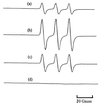Induction of oxyradicals by arsenic: implication for mechanism of genotoxicity
- PMID: 11172004
- PMCID: PMC29310
- DOI: 10.1073/pnas.98.4.1643
Induction of oxyradicals by arsenic: implication for mechanism of genotoxicity
Abstract
Although arsenic is a well-established human carcinogen, the mechanisms by which it induces cancer remain poorly understood. We previously showed arsenite to be a potent mutagen in human-hamster hybrid (A(L)) cells, and that it induces predominantly multilocus deletions. We show here by confocal scanning microscopy with the fluorescent probe 5',6'-chloromethyl-2',7'-dichlorodihydrofluorescein diacetate that arsenite induces, within 5 min after treatment, a dose-dependent increase of up to 3-fold in intracellular oxyradical production. Concurrent treatment of cells with arsenite and the radical scavenger DMSO reduced the fluorescent intensity to control levels. ESR spectroscopy with 4-hydroxy-2,2,6,6-tetramethyl-1-hydroxypiperidine (TEMPOL-H) as a probe in conjunction with superoxide dismutase and catalase to quench superoxide anions and hydrogen peroxide, respectively, indicates that arsenite increases the levels of superoxide-driven hydroxyl radicals in these cells. Furthermore, reducing the intracellular levels of nonprotein sulfhydryls (mainly glutathione) in A(L) cells with buthionine S-R-sulfoximine increases the mutagenic potential of arsenite by more than 5-fold. The data are consistent with our previous results with the radical scavenger DMSO, which reduced the mutagenicity of arsenic in these cells, and provide convincing evidence that reactive oxygen species, particularly hydroxyl radicals, play an important causal role in the genotoxicity of arsenical compounds in mammalian cells.
Figures





Similar articles
-
Arsenic induces oxidative DNA damage in mammalian cells.Mol Cell Biochem. 2002 May-Jun;234-235(1-2):301-8. Mol Cell Biochem. 2002. PMID: 12162448
-
Sodium arsenite and arsenic trioxide differently affect the oxidative stress, genotoxicity and apoptosis in A549 cells: an implication for the paradoxical mechanism.Environ Toxicol Pharmacol. 2013 Nov;36(3):891-902. doi: 10.1016/j.etap.2013.08.002. Epub 2013 Aug 14. Environ Toxicol Pharmacol. 2013. PMID: 24004876
-
Mutagenicity of cadmium in mammalian cells: implication of oxidative DNA damage.Mutat Res. 2004 Feb 26;546(1-2):81-91. doi: 10.1016/j.mrfmmm.2003.11.006. Mutat Res. 2004. PMID: 14757196
-
Sodium arsenite induces cyclooxygenase-2 expression in human uroepithelial cells through MAPK pathway activation and reactive oxygen species induction.Toxicol In Vitro. 2013 Apr;27(3):1043-8. doi: 10.1016/j.tiv.2013.01.012. Epub 2013 Jan 30. Toxicol In Vitro. 2013. PMID: 23376440
-
Role of oxyradicals in mutagenicity and DNA damage induced by crocidolite asbestos in mammalian cells.Cancer Res. 1999 Dec 1;59(23):5922-6. Cancer Res. 1999. PMID: 10606236
Cited by
-
Bacillus cereus strain S2 shows high nematicidal activity against Meloidogyne incognita by producing sphingosine.Sci Rep. 2016 Jun 24;6:28756. doi: 10.1038/srep28756. Sci Rep. 2016. PMID: 27338781 Free PMC article.
-
Genomic analysis of stress response against arsenic in Caenorhabditis elegans.PLoS One. 2013 Jul 24;8(7):e66431. doi: 10.1371/journal.pone.0066431. Print 2013. PLoS One. 2013. PMID: 23894281 Free PMC article.
-
Acute Sodium Arsenite-Induced Hematological and Biochemical Changes in Wistar Rats: Protective Effects of Ethanol Extract of Ageratum conyzoides.Pharmacognosy Res. 2016 Mar;8(Suppl 1):S26-30. doi: 10.4103/0974-8490.178645. Pharmacognosy Res. 2016. PMID: 27114688 Free PMC article.
-
Manganese attenuates the effects of arsenic on neurobehavioral and biochemical changes in mice co-exposed to arsenic and manganese.Environ Sci Pollut Res Int. 2019 Oct;26(28):29257-29266. doi: 10.1007/s11356-019-06112-y. Epub 2019 Aug 8. Environ Sci Pollut Res Int. 2019. PMID: 31396869
-
Mechanisms of the genotoxicity of crocidolite asbestos in mammalian cells: implication from mutation patterns induced by reactive oxygen species.Environ Health Perspect. 2002 Oct;110(10):1003-8. doi: 10.1289/ehp.021101003. Environ Health Perspect. 2002. PMID: 12361925 Free PMC article.
References
-
- Garica-Vargas G G, Cebrian M E. In: Toxicology of Metals. Cheng P, editor. Boca Raton, FL: CRC; 1996. pp. 423–438.
-
- Chan P C, Huff J. Environ Carcinog Ecotoxicol Rev. 1997;C15:83–122.
-
- Leonard A, Lauwerys R R. Mutat Res. 1980;75:49–62. - PubMed
Publication types
MeSH terms
Substances
Grants and funding
LinkOut - more resources
Full Text Sources
Other Literature Sources
Miscellaneous

